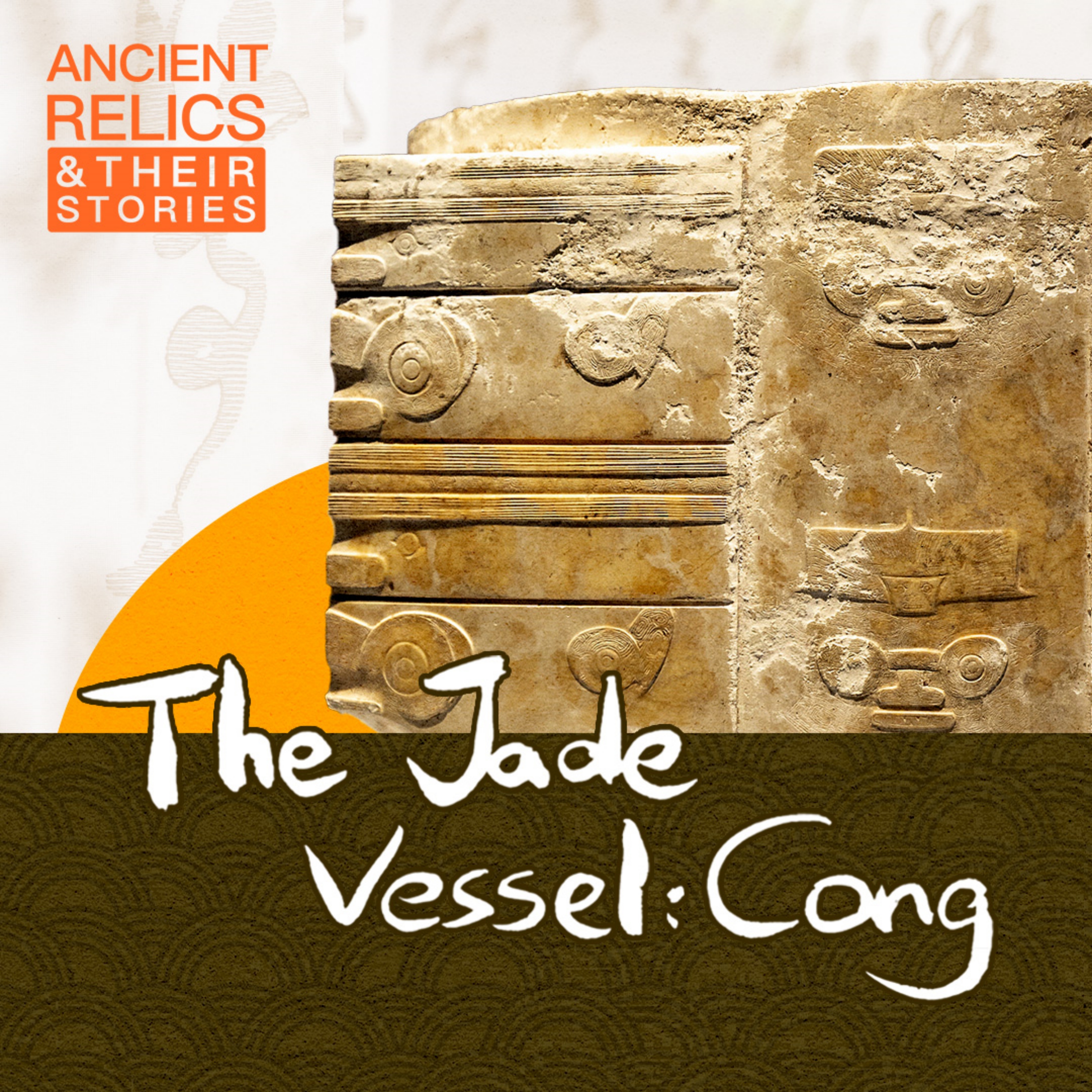
Cong: The jade vessel which assisted governance in ancient China

A Thousand Whys
Deep Dive
Shownotes Transcript
Jade was a cornerstone of spiritual and social life in the early stages of Chinese civilization, as it bears multifaceted meanings such as wealth, social rank, as well as personality and moral integrity.
Sacrificial vessels played a key role in bringing people together as a tribe or a city, guiding people in their dialogue with the heavens and earth. Putting the two together, we have jade vessels with ideological and practical impacts on the development of civilization. Today, on Ancient Relics and Their Stories,
we feature a jade vessel that helps patch people together as a city or a country at its earliest stage, regulating life, work and behaviour. It's called the King of Jade Cong, one of the most remarkable discoveries of the Liangzhu culture, a civilisation that flourished over 5,000 years ago in the Yangtze River Delta. Unearthed from a royal burial site in today's Zhejiang province,
This magnificent Cong or vessel is now preserved in the Zhejiang Provincial Museum. Among all the artefacts from the Liangzhou Civilisation, this one stands apart from other Congs, not just for its size and intricate carvings, but for the profound meanings it carries. Jade artefacts played a central role in culture, serving as symbols of power and spirituality, and as essential tools in rituals connecting people with the heavens and the earth.
The Jetsong King stands out as a masterpiece of craftsmanship and meaning, especially a spiritual or religious belief in a society way before it was known as religion. But what exactly was the Liangzhu culture? And why does this song matter so much? Let's journey back to the summer of 1986 to Yuhang in Zhejiang province. There, a team of archaeologists unearthed a cluster of elite tombs, astonishingly well-preserved.
These tombs were located on a monumental man-made platform about six meters high, covering an area half the size of a football field. Tomb number 12 belonged to a man of extraordinary status. He was surely somebody of immense rank and influence, as his underground palace was surrounded by more than 600 jade artifacts. The King of Jade Cong is the largest and most intricately crafted,
it is more than just an ordinary work of art. It is characterised by its distinctive square ulterior and hollow circular core, a design that embodies the ancient Chinese concept of "tian yuan di fang" or "heavens as round and the earth as square". This philosophy reflects the Liangzhou people's belief in the vast universe, its cosmic harmony and the interconnectedness of heaven and earth.
The combination of square and circular elements symbolizes balance and unity, central to their worldview and religious practices. Take a closer look and you will see the four sides of the vessel adorned with intricate carvings. Each side is divided into two sections by a horizontal groove.
On the upper section is a figure wearing a feathered headdress, its face calm and dignified, with arms extending outward as if in a gesture of command. Below this figure lies the face of a fierce beast, its sharp claws poised with raw power. Together,
They create the commanding image of a divine figure riding a mighty beast, a motif of majesty and spiritual significance. Adding to this imagery are flowing patterns like clouds which bring a sense of movement and life to the static carvings. Above the figures and beasts, a bird with outstretched wings appears, guiding them towards the heavens.
This design, gods, beasts and birds, repeats on all four sides of the Cong, creating a unified and dynamic visual narrative. From every angle, the King of Jade Cong radiates a sense of mystery and reverence, serving as the centrepiece of Liangzhu's most sacred rituals.
Such divine motifs were not unique to the King of Jade Cong. They are found across many Cong artefacts unearthed at Liangzhou sites. Yet this particular piece represents the pinnacle of artistic and spiritual belief and the core values of Liangzhou culture. One can easily envision ancient rituals centred around this jade vessel. A god commanding a beast, a sacred bird soaring above,
all illustrated by flickering firelight as worshippers pray for harmony, prosperity and the blessings of the heavens. But to truly understand the significance of the King of Jaicheng, we must look beyond its artistry to the society that created it. Liangzhu is no ordinary tribe. It's a city or perhaps even the earliest kingdom in Chinese history.
Imagine a civilisation that thrived over 5,000 years ago, built on intricate systems of regional division of labour, social hierarchy and industry specialisation. This level of complexity demanded not only a sophisticated social structure but also a way to coordinate and regulate its people, lands and resources effectively and in good order.
Flourishing between 3,300 and 2,300 years BCE in the Yangtze River Delta around Taihu Lake, the Liangzhu culture was far ahead of its time. Its success was anchored in three defining achievements: advanced rice farming, a large-scale water management network, and a ritual system that reflected its organized and hierarchical society.
Rice farming formed the backbone of Liangzhu's prosperity and distinguished it from many contemporary cultures. Archaeologists have uncovered extensive evidence of advanced rice cultivation at sites like Maoshan near Lingping, where the fields featured drainage ditches, irrigation channels and embankments remarkably similar to modern-day rice paddies.
Within the city, granaries such as the Shizhong Temple Granary stored an astounding 360,000 kilograms of rice. These granaries were thoughtfully designed to prevent fires and streamline transportation, showcasing the Liangzhou people's agricultural innovation and ability to maintain a stable food supply.
To safeguard their crops from floods and droughts, the Liangzhu people created one of the world's earliest large-scale water management systems. They constructed moats, dams and walls to control flooding and ensure a steady flow of water for irrigation. These hydraulic projects highlight the Liangzhu civilization's exceptional ingenuity and environmental adaptability.
With abundant resources and infrastructure to protect them, Liangzhou society flourished. This prosperity enabled the development of a well-organised social system. The Liangzhou people specialised in various roles. Farmers worked the fields, hunters and fishers also provided food, and skilled artisans focused on crafting extraordinary jade artefacts like the Congs.
As wealth grew, social stratification became more pronounced, with powerful leaders at the top, artisans and specialists in the middle, and labourers forming the foundation of the community. To sustain social harmony and express their collective values, the Liangzhou people turned to religion and elaborate rituals.
These ceremonies served as both spiritual practices and mechanism of social cohesion reflecting a deep reverence for the heavens and earth. It was within this context that jade tongs emerged, not merely as tools for worship but as a profound symbol of their beliefs, aspirations and sophisticated civilization. To imagine the grandeur of Liangzhu rituals, picture this. Across the Liangzhu realm,
Ceremonies of various scales were meticulously organised, culminating in the most awe-inspiring events at the heart of the Liangzhou capital. A top-towering man-made platform surrounded by the massive city walls, the grandest rituals unfolded. These platforms, designed to elevate the sacred place closer to the heavens, symbolised the connection between the mortal and the divine.
These ceremonies were presided over by the highest-ranking rulers and priests, showcasing the pinnacle of spiritual and political power. Among the ceremonial objects used in these magnificent rituals, the King of Jetsong held the highest place of honour. As the largest and most intricately crafted tsong ever discovered, its sheer size and exquisite carvings reflected its commanding role in the most significant and solemn ceremonies.
The King of Jie Cong was not just an artefact It was the ultimate expression of reverence a spiritual bridge to the heavens and a powerful symbol of the Liangzhu people's beliefs and aspirations Its central role in these rituals underscores the profound connection between material objects and the spiritual world in Liangzhu culture
The Liangzhu belief system was deeply rooted in the balance and harmony between heaven and earth, and also most definitely its people. Representing elements such as the sun and moon in the sky, soil and water on the ground, this philosophy unifies their worldview and practices.
The cultural sites scattered across the Taihu Lake appear to form an interconnected network of faith and ritual, eliminating a shared spiritual narrative that bound the Liangzhou people together. This framework of beliefs and ceremonies influenced not only the Liangzhou civilization itself, but also the religious and cultural development of later Chinese societies.
At the core of this belief system were ceremonial objects like the jade cong, guiding beliefs and calling for order. The king of jade cong is certainly the gateway to this desire. Today, the legacy of Liangzhu culture is scattered across the Yangtze River Delta. Numerous archaeological sites in Jiangsu, Zhejiang and Shanghai reveal glimpses of this ancient civilization and administration in its first expression.
It now ranks among the top 10 exhibits at the Zhejiang Provincial Museum, telling the stories about how this land of abundance emerged and flourished, laying a cornerstone of Chinese beliefs and governance through a bridge that joins the spiritual world with the secular. That concludes today's episode of Ancient Relics and Their Stories. I'm Ling Xiaowen.
We'd like to thank the Zhejiang Provincial Museum and Ms Wu Shih-He for sharing their insights into the king of jade cong and its links with the Liangzhu culture. In our next episode, we'll dive into the story of a boat-shaped celadon water dropper, a tool once used in Chinese calligraphy and painting. With its jade-like glaze, this dropper helped create delicate gradients of ink.
bringing words and landscapes to life and reflecting the artist's inner thoughts on paper. Thank you for joining us. Until next time, goodbye.